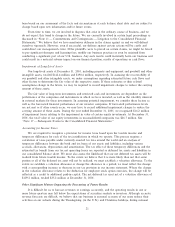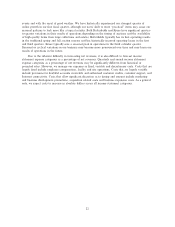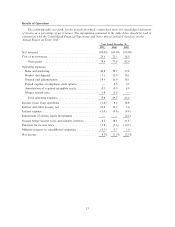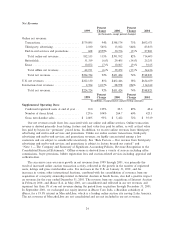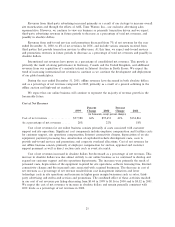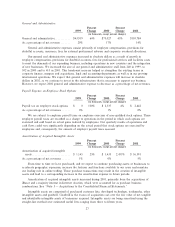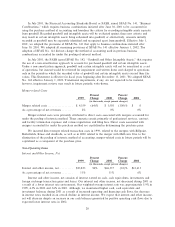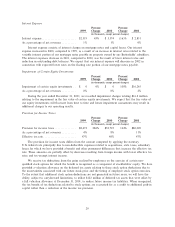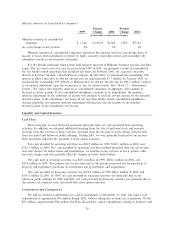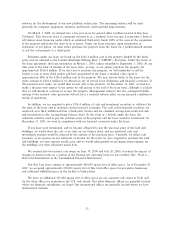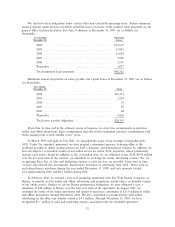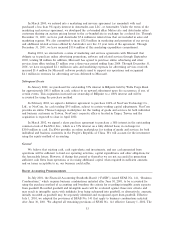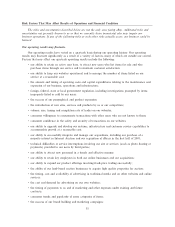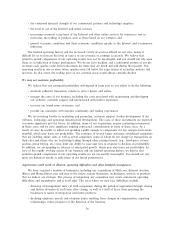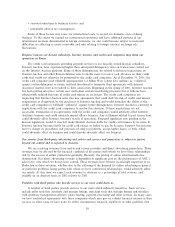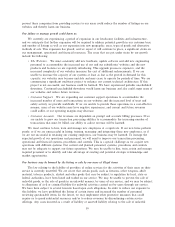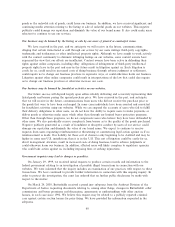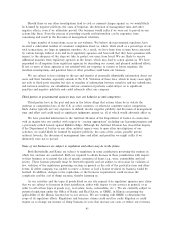eBay 2001 Annual Report Download - page 35
Download and view the complete annual report
Please find page 35 of the 2001 eBay annual report below. You can navigate through the pages in the report by either clicking on the pages listed below, or by using the keyword search tool below to find specific information within the annual report.software for the development of our new platform architecture. The remaining balance will be used
primarily for computer equipment, furniture and Ñxtures and leasehold improvements.
On March 1, 2000, we entered into a Ñve-year lease for general oÇce facilities located in San Jose,
California. This Ñve-year lease is commonly referred to as a synthetic lease because it represents a form of
oÅ-balance sheet Ñnancing under which an unrelated third-party funds 100% of the costs of the acquisition
of the property and leases the asset to us as lessee. Under our lease structure, upon termination or
expiration, at our option, we must either purchase the property from the lessor for a predetermined amount
or sell the real property to a third-party.
Payments under our lease are based on the $126.4 million cost of the property funded by the third-
party and are adjusted as the London Interbank OÅering Rate (""LIBOR'') Öuctuates. Under the terms of
the lease agreement, the lease terminates on March 1, 2005, unless extended to September 1, 2006. At any
time prior to the Ñnal 12 months of the lease term, we may, at our option, purchase the property for
approximately $126.4 million. If we elect not to purchase the property, we will undertake to sell the
facility to one or more third parties and have guaranteed to the lessor a residual value equal to
approximately 88% of the $126.4 million cost of the property. We may also be liable to the lessor for the
entire amount of $126.4 million if we default on any of certain lease obligations and Ñnancial covenants. If
this payment were made, we would then receive title to the property. At December 31, 2001, we had not
made a decision with respect to the option we will pursue at the end of the lease term, although it is likely
that we will decide to continue to occupy the property. Management believes that the contingent liability
relating to the residual value guarantee will not have a material adverse eÅect on our Ñnancial condition or
results of operations.
In addition, we are required to place $126.4 million of cash and investment securities as collateral for
the term of the lease and to maintain certain Ñnancial covenants. The cash and investment securities are
restricted as to their withdrawal from a third-party trustee and are classiÑed as long-term restricted cash
and investments in the accompanying balance sheet. In the event of a default under the lease, the
collateral could be used to pay the purchase price of the property and the lease would be terminated. At
December 31, 2001, we were in compliance with our Ñnancial covenants under the lease.
If our lease were terminated, and we became obligated to pay the purchase price of the land and
buildings, we would show the cost as an asset on our balance sheet and our restricted cash and
investments position would be reduced by the amount of the purchase price. Currently, we reÖect rent
payments as an expense on our statement of income. In the event we were required to purchase the land
and buildings, our rent expense would cease and we would subsequently record depreciation expense for
the buildings over their estimated useful lives.
We entered into two interest rate swaps on June 19, 2000 and July 20, 2000, to reduce the impact of
changes in interest rates on a portion of the Öoating rate operating lease for our facilities. See ""Note 6 Ì
Derivative Instruments to the Consolidated Financial Statements.''
Our San Jose lease consists of approximately 460,000 square feet of oÇce space. As of December 31,
2001, we occupied approximately 230,000 square feet of this total oÇce space for our online businesses
and subleased additional space in the facility to third parties.
We lease an additional 301,000 square feet of oÇce space for our customer call center in Utah and
for the other oÇces we maintain in the U.S. and abroad. Our other domestic oÇces are generally located
where our domestic subsidiaries are based. Our international oÇces are generally located where we have
international websites.
31


